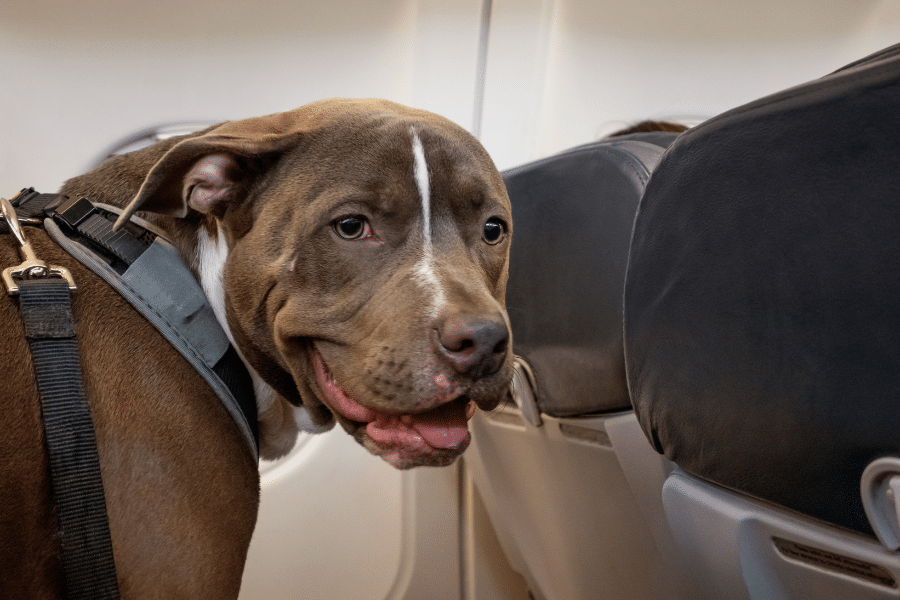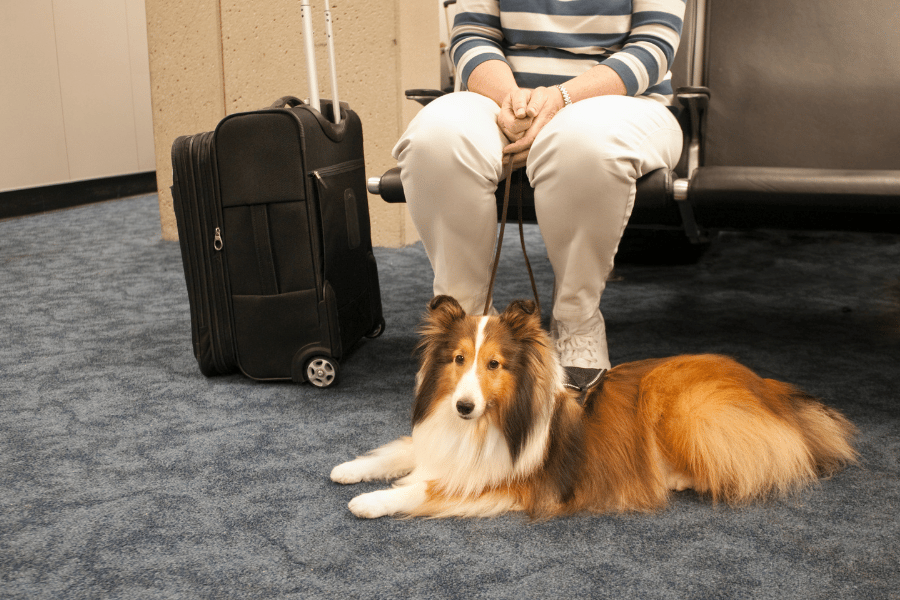Traveling with a dog can be an exciting and rewarding experience, but it takes proper planning and preparation to ensure that your furry companion has the best possible travel experience. Whether you’re looking to spend a vacation on the sandy beaches of Spain with your pooch or moving to a new home in Italy, traveling or moving to Europe with a dog opens up many opportunities to explore Europe while spending quality time together. This article will provide helpful tips on the best way to travel to Europe with a dog.
What you should know before traveling to Europe with a dog
If you’re moving to Europe with a dog, it will take considerable forethought to ensure a smooth and successful journey. Planning can help pet owners avoid potential complications and stress when taking their pets to Europe. From gathering documentation for transportation purposes to being mindful of local laws for each country visited, here’s what you should know to make your trip as stress-free as possible.
To start, you will need an international health certificate issued by a veterinarian that outlines the condition of your canine, vaccination history, and any medications they may require during travel. Obtaining this certificate is often the most time-consuming part of the planning process. Many countries in Europe have specified that it must be signed within 10 days before departure while others muster up requirements regarding minimum distances between vaccinations or issuing date parameters.
Accordingly, researching European Union’s policies surrounding pet entry at least one month before leaving for Europe is essential for ensuring an expeditious experience at the points of departure and arrival.
Aside from making sure your dog is in optimal health, familiarizing yourself with local businesses’ pet policies when planning accommodations abroad will prove to be invaluable knowledge beforehand. With 4 and 5-star hotels frequently enforcing a ‘no pets allowed’ policy, Airbnb or guesthouses may be more suitable for keeping you and your pup satisfied throughout the journey. Additionally, consulting dog-friendly websites like Bring Fido can help narrow down areas that promote canine friendliness when it comes to hotels, restaurant patios, and scenic trails.
Finally, always having access to veterinary services if an emergency arises is a must while traveling with your pup overseas. Doing research ahead of time concerning the availability of these medical facilities in areas you’ll be visiting is essential since they tend to fluctuate greatly depending on where one goes in Europe. Always bring important healthcare documentation regarding vaccination shots as different countries will require them before allowing access to their services. Nevertheless, knowing the above information and planning ahead of time for a European adventure with your pup will help make sure both pet and owner have an exceptional experience.
Steps to take before traveling to Europe with your dog
To get a dog to Europe, it is essential to start by researching any regulations related to traveling overseas with a canine companion. Regulations can vary depending on the country of destination. Currently, most European countries require certain vaccinations at least 21 days before departure, so it’s important to consult with your veterinarian beforehand and make sure all necessary shots have been administered. Additionally, paperwork such as an international health certificate signed by a licensed vet is often compulsory when crossing borders.
In addition to vaccine requirements and proper documentation, you’ll need to consider various practical matters while planning for the trip. Purchasing a pet-approved airline carrier or kennel that meets size regulations is essential in ensuring your dog remains safe during flights. Furthermore, certain lodging facilities may or may not be pet-friendly so it is wise to check ahead of time and book accommodations accordingly.
Before embarking on your adventure, make sure the provisions necessary for taking care of your pal are in order. Have plenty of travel food available and consider packing some familiar items from home such as blankets and toys that can offer comfort during long journeys. Most importantly, take into account your dog’s temperament when planning activities. By taking the necessary steps and researching ahead of time, traveling to Europe with your four-legged friend can be an enjoyable and once-in-a-lifetime experience for both of you.
Travel documents for pets who are moving abroad
To meet all the legal requirements in order to move to Europe with a dog, you will need an official document confirming fitness for travel – also known as an international health certificate. This certificate must be provided by a vet, who should be listed on the register of authorized veterinarian inspectors to sign off on one’s pet and provide them with their passport.
The certificate contains information such as vaccination details and proof that all relevant tests have been taken before departure – including rabies results among other essential health checks considering the animal is traveling outside its jurisdiction. An official stamp or seal must also come from local authorities or government-approved bodies endorsed for use in international movements of pets. An EU pet passport is also required, which includes similar information.
Lastly, owners should never feel that obtaining such documentation is a stressful endeavor; many agencies exist to make it as hassle-free as possible, offering owners peace of mind throughout special travel arrangements or preparations. As long as one knows where to look ahead of their journey, any pet owner should feel confident about embarking on an international venture with their beloved companion.
How much does it cost to fly a dog to Europe?
The cost associated with getting your dog to another country can add up to several hundred dollars. If you wish to travel with your dog in the cabin or kennel, the cost is estimated to be around $100 to 200 dollars. Generally speaking, an international health certificate will cost $265, and an EU Pet Passport will cost between €20 and €448, plus additional charges related to specific testing or services that may be required by your destination country. It is important to contact your local veterinarian before planning any trips abroad to find out what documents they need and how much it will all costs.
Before booking your dog’s ticket on any flight, it is important to review the guidelines and policies of both the airline you plan to use as well as customs regulations of your destination country, you don’t want any surprises during takeoff. As daunting and expensive as traveling with a pet can be, patience and proper preparation will guarantee that both you and your four-legged friend enjoy the wonderful opportunity to explore all that Europe has to offer.
How to get a dog to Europe without flying
Given the increasing popularity of traveling with one’s canine companion, it is understandable that individuals are often seeking out the answer to how to move abroad with a dog. Rather than employing air travel, which can be both expensive and stressful for animals given its stringent regulations and cramped confines, other viable options exist.
These include traveling by car or boat, each offering a different set of challenges yet both potentially being more practical solutions when compared to flying overseas with your pet.
One transportation option available for getting a dog to Europe would be an automobile, if you are traveling from the UK for example. Although road-tripping takes a bit of planning and effort, the advantages can make it worthwhile as you are given more control when driving your vehicle with your pup as opposed to being restricted by airline rules and regulations.
This allows individuals greater freedom in terms of how much pet-related equipment they can bring along such as food, bedding, toys, dog carriers, or even crates if needed during overnight stops.
Some items might not meet checked baggage weight requirements when flying on commercial airlines. Furthermore, the car journey can be broken up into myriad stopovers where both you and your pet will have a chance to stretch your legs, allowing for brief tours of some smaller countries or towns along the way that might otherwise remain unseen if flying was an option instead.
Another conceivable means of bringing a dog to Europe is via boat. This could include ferries that traverse larger bodies of water including across multiple countries if taking a longer route such as from North America to mainland Europe. Here, families could bring along their dog while taking in some breathtaking views often accompanied by onboard dining or recreational activities during the voyage.
Moreover, ferries might be a more relaxed means of travel for pets who prefer life on land thus helping avoid potential motion sickness-inducing airplane flights. And depending on destination and ship size, cabins may also sometimes be available to provide passengers with additional creature comforts, proving an extra level of psychological safety and security that flying simply can not provide.
Are there dog breed restrictions on flights to Europe?
For some airlines, there are breed restrictions for certain dogs. Depending on the neighboring countries’ varying policies, certain breeds may be subject to additional costs or even denied access altogether, such as Pit Bulls and Staffordshire Terriers. As such, researching ahead of time could save you quite a bit of frustration come departure day.
When traveling abroad, it is important to check if the airline allows pets on board in advance. While many airlines provide services for dogs, transporting certain breeds can often bring an additional set of restrictions due to varying regulations regarding size limitations or even legal issues with neighboring countries that may need transiting by air. Consequently, being able to confirm what limitations exist before initial flight booking can save much unnecessary stress before embarking.
Additionally, breed limitations come into play depending on where the pet is heading. Some countries intrinsically forbid certain breeds altogether, either due to threat aggression or simply by law. Having accurate information prior and seeking expert advice in such cases can avoid any unwelcome surprises during travel. Consequently, exercising caution when opting for an international flight with pets could save not only money but also unnecessary headaches later down the line happy travels.
When planning a move abroad with your pets, being prepared is key. Check out this ultimate moving abroad checklist for a well-organized experience.




